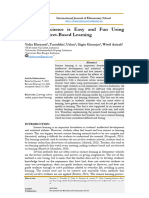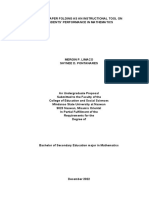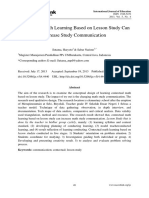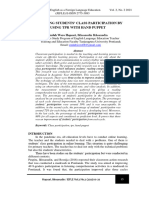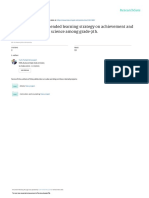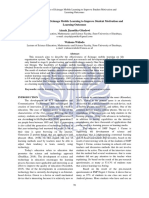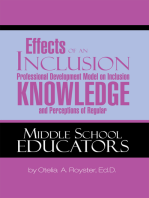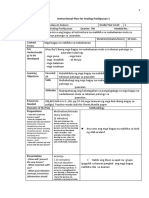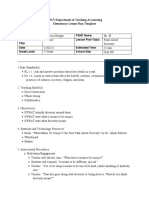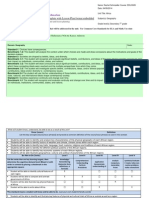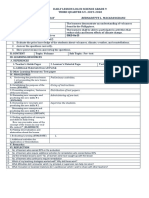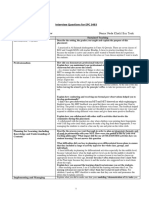The Effectiveness of Interactive Multimedia in Mathematic Learning. (Utilizing Power Points For Students With Learning Disability)
The Effectiveness of Interactive Multimedia in Mathematic Learning. (Utilizing Power Points For Students With Learning Disability)
Uploaded by
Nur UtamiCopyright:
Available Formats
The Effectiveness of Interactive Multimedia in Mathematic Learning. (Utilizing Power Points For Students With Learning Disability)
The Effectiveness of Interactive Multimedia in Mathematic Learning. (Utilizing Power Points For Students With Learning Disability)
Uploaded by
Nur UtamiOriginal Description:
Original Title
Copyright
Available Formats
Share this document
Did you find this document useful?
Is this content inappropriate?
Copyright:
Available Formats
The Effectiveness of Interactive Multimedia in Mathematic Learning. (Utilizing Power Points For Students With Learning Disability)
The Effectiveness of Interactive Multimedia in Mathematic Learning. (Utilizing Power Points For Students With Learning Disability)
Uploaded by
Nur UtamiCopyright:
Available Formats
International Journal of Pedagogy and Teacher Education (IJPTE) (Vol.
1 Issue 1 | April 2017)
The Effectiveness of Interactive Multimedia in Mathematic Learning.
(Utilizing Power Points for Students with Learning Disability)
Widodo Dwi Riyanto1, Gunarhadi1
1
The Faculty of Teacher Training and Education, Universitas Sebelas Maret, Indonesia
Corresponding email: widododwiriyanto@gmail.com
ABSTRACT
The fact shows that students with learning disability need media of
learning mathematics. The purpose of this study was to (1) develop interactive
learning multimedia of power point, and (2) examine the effectiveness of power
point in mathematics learning. The sample was a group of students in elementary
school in Ngawi, East Java, Indonesia, especially those with learning disability.
This study was a research and development comprising three stages: preliminary
study, product development, and testing the effectiveness of the product. The data
were collected through questionnaires, interviews and tests, then analyzed by
descriptive qualitative, and t-test was to analize the effect of the product. In the
development stage, the result showed that Experts validation is high as indicated
by the mean score of 4.50 for the learning material, and the mean score of 4.44 for
quality of the multimedia. The trial results showed that the quality of multimedia
was very good as indicated by the mean score of 4.32. In term of the effectiveness
of the product, the result from the t-test shows an increase of 14.27 (21.88%).
This means that the interactive learning multimedia of power point improves the
achievement of mathematic learning for students with learning disability in
mathematics..
Keywords: Interactive multimedia, Power Point, Mathematics, Research and
Development, Learning Media.
Paper | 7 ISSN: 2549-8525 Page | 55
International Journal of Pedagogy and Teacher Education (IJPTE) (Vol.1 Issue 1 | April 2017)
INTRODUCTION
Learning mathematics at school is considered important because in the
educational curriculum, mathematics is a compulsory subject at every level of
education from kindergarten through college. It is believed that mathematics is a
tool for seeking solutions to the various problems in daily life. This view is in
line with Hudojo (2005: 35) who said that mathematics is a tool to develop a way
of thinking regarding the logical concept and structured ideas.
In practice, as a matter of fact, many students with learning disability assume that
mathematics is difficult (Harwell, 2001). This makes sense because most of them
have problems of abstraction in learning. Basically, as stated by Thobroni (2011),
learning is the process of constructing knowledge by way of abstracting the
experience as a result of interaction between students and reality; personal reality,
the reality of nature, or social reality. Abstraction of experience makes these
students difficult. Moreover when used in interactions within the instructional
process, the media are often utilized inappropriately.
It also happened to students in SD Muhammadiyah Ngawi. This is indicated by
the low scores of students’ test in the 2nd half in the academic year of 2014/2015,
particularly when compared with the other subjects. The mean score obtained by
students in the subject of Mathematics is 7, 48. While Indonesian score is 9, 00
and IPA (Natural Sciences) is 8, 50.
Another result was found in observation in the third grade of SD Muhammadiyah
Ngawi and interviews with math teachers and students. They find that there were
difficulties in learning mathematics at the school related to the learning activities.
In the process of learning, the students often acted as if paying full attention to the
teacher's explanations, yet they found themselves hard in completing the exam
questions. From interviews with students in the class, 13 out 25 students said that
mathematics was not fun, and their interest in mathematics was only about fifty
percent. The students’ statement in the interview indicated that the learning
process was only going one way. The classroom atmosphere which was quiet and
full of concentration made the students uncomfortable since they just listened to
the teacher's explanation. Learning media provided to students were only in the
form of stickers or pictures in textbooks which, of course, were less attractive to
students. Thus, the interaction between students and teachers was too little. As a
result, classroom learning seemed to be monotonous and boring. Such a condition
is quite alarming since elementary school is the basic level of the whole process
of further education.
Based on these facts, the further study on the issue is indispensable for a teacher
to help students to improve their learning achievement in mathematics. One
important thing to be noted here is that mathematics should be explained in a
more interactive way to make the students more interested in this lesson.
However, the problem remains there, because most teachers are burdened with
additiona administrative tasks of the institution (school). Therefore, the researcher
is highly concerned with the solution to this problem by developing interactive
multimedia. Vaughan (2008: 6) states that multimedia would spur radical changes
in teaching and learning. The benefits of using of multimedia are as listed in the
Paper | 7 8 ISSN: 2549-8525 Page | 56
International Journal of Pedagogy and Teacher Education (IJPTE) (Vol.1 Issue 1 | April 2017)
following points such as: (a) students who are achieving could be honed in their
abilities, (b) the change of model will change the passive to become active
learners accordingly, (c) the teacher's role is no more than as a guide, mentor or
facilitator in the learning activities, (d) the students become the center of the
learning activities (student-centered).
One of the interactive multimedia which serves a suitable solution to the problem
in this study is power point. This media can contain photos, videos and music to
make learning more interactive. Utilization of multi-media will give big impact on
the students’ spirit of learning. Simple operation of multi-media makes it easy for
teachers to use during the instruction.
Many people, as a matter of fact, consider Power Point as a medium of
presentation only. Yet, according to Munir (2012, 19) "If media has the elements
in the form of ... navigation, simulation, game and exercise to control these
elements, multi media are powerful to function as interactive Multimedia ". In this
case, Power Point can contain all of these elements. Then, PowerPoint can be
regarded as interactive multimedia. The focus of the problem in this research was
how to produce contents of multimedia to support the needs of mathematic
learning as how to make the the class interactive that the students learn and
achieve better in mathematics.
RESEARCH METHOD
This research was located in SD Muhammadiyah 1 Ngawi, Ngawi, East Java
Province with a sample of 90 students (30 students of the experimental class, 30
students in control class, and 30 in experiment class). The type of research that
was used was a mixed method research to product development known as
Research and Development (R & D). According Sugiyono (2009: 407), research
and development (R & D) is a research method that is used to produce a specific
product and test the effectiveness of the product.
As before doing the research, researchers conducted a preliminary study. This
stage aimed to obtain information on how the process of learning mathematics
was running so far in the third grade of Elementary School. The next step was
conducting a needs assessment or needs analysis. This analysis included analysis
of the curriculum, the characteristics of mathematics learning, student
characteristics and the utlilization of media of learning mathematics. On the
further stage, the researchers conducted placement of the basic competencies and
learning objectives developed in interactive multimedia. This was the result of
discussion and consideration of the various subject teachers of Mathematics.
Next, the researchers made the design of interactive multimedia for class III in
Mathematics. This phase included the design of the display material in interactive
multimedia including image selection instruction, video support and training
which was appropriate to the material and the purpose of this multimedia
production. Before this product was applied and tested, it must first be validated
by experts. The validation phase was divided into two, namely material validation
and media validation. Material validation was performed by an expert of the
subject matter. The goal was to get an expert assessment of materials related to
Paper | 7 8 ISSN: 2549-8525 Page | 57
International Journal of Pedagogy and Teacher Education (IJPTE) (Vol.1 Issue 1 | April 2017)
the material presented. The media validation was performed by a media expert.
The objective of this phase was to get an assessment of the feasibility of media
associated with the media developed. The data in this validation was obtained
through a questionnaire filled out by the experts.
The last was the stage of evaluation of the data obtained from questionnaires and
achievement tests that have been given in earlier stages. The evaluation results
were used as a reference to see whether or not the media was eligible for use as
final product. Related to the collection of data, the researcher used a test of
effectiveness of the product to measure the feasibility of the media. The data
obtained after the product evaluation, then, was analyzed using statistical tests (t-
test) by using Ms.Excell and SPSS statistic- 23.
RESEARCH RESULTS
After going through the design and evaluation of the experts, the researchers then
produce multimedia that have been planned in advance. An example of display of
the media production can be seen in the following figure:
Figure 1. Learning materials (measurement of time)
In this step, the data collected by the researchers was obtained from the
prerequisite test and validated the results to see the feasibility of the content or the
material of media from the experts (Media and Materials). The results of the
validation of the material can be described in following table.
Table 1 Results of assessment by the Content Expert
Validation of Total Answers Mean total questions
Content Expert
1 2 3 4 5
1 - - - 9 8 4,47 17
2 - - - 10 7 4,41 17
Total - - - 19 15 - -
Based on the results of a calculation validation of subject matter experts, the
researcher found that the content of the material presented in PowerPoint
Multimedia development was as much as 44% stated very good, and 45% were
good, with an average score of 4.44 or 89%. When converted on a scale of 5, then
these results were included in the category of "Very Good". Thus, it can be
Paper | 7 8 ISSN: 2549-8525 Page | 58
International Journal of Pedagogy and Teacher Education (IJPTE) (Vol.1 Issue 1 | April 2017)
concluded that the content of the material in the products developed were feasible
for use as a Multimedia PowerPoint in mathematics.
Furthermore, the validation results by the media experts can be described as in
following table.
Table 2 Mean Score Rated by Media Expert
Aspect Rating Mean Score
Display 4,44
Presentation 4,56
Mean Total 4,50
Based on the result of the validation results by media experts, the researcher
concluded that the presentation of the products developed was feasible for use
with revisions in several parts:
(a) Media expert I: support the product by sound though only slowly and by the
icon to turn on or turn off the music, and give a different color on the
hyperlink.
(b) Media expert II: add backsound so this product does not seem boring and
multiply examples of products.
Overall, based on the data that has been collected and analyzed, it can be
concluded that the Multimedia PowerPoint meets the eligibility criteria to be
tested in the field. Before testing, the researcher conducted a test for normality to
the experimental group and the control group with the provision that if the
significance value greater than 0.05, this data can be regarded as normal
distribution. Based on the results obtained, it was concluded that the sample had a
normal distribution for both groups for a significant level of more than 0.05, (0,
166 and 0.121).
Other prerequisite test conducted was the test of homogeneity. This test has
provisions similar to normality test. Based on the results, significant value of the
control and experimental class homogeneity test was 0.634, more than 0.05. Thus,
it can be stated that both the data was homogeneous.
After going through the stages of the prerequisite test only then field tests can be
performed. After the field test, all the data obtained were analyzed using T test
with the following results:
Table 3 Independent Sample t-test
T df Sig. (2-tailed)
Pre-Test 22.76 29 .000
Post-Test 59
Based on the data, it can be seen that | t | = 22, 76 while the t table with df 29=
1,699, hence, it can be concluded that the results were to prove that Ho was
rejected. Thus, it could be said that there was a significant difference between the
Paper | 7 8 ISSN: 2549-8525 Page | 59
International Journal of Pedagogy and Teacher Education (IJPTE) (Vol.1 Issue 1 | April 2017)
learning outcomes before and after using the interactive media, With the average
increase in value of 12, 27 or 21, 88%.
DISCUSSION
The process of product development, in this research, in the form of multimedia
learning program in Mathematics, was developed through several stages of
development. The stages included: requirements analysis stage, the stage of
product design, product development stage, the stage of implementation and
evaluation stages
The Multimedia product was developed based on the needs analysis that was
described before. The manufacturing process was to gather materials and
resources that were relevant to support the development of the multimedia. The
element which was contained in this phase included the preparation of materials,
basic competence, and the design of instructional media.
The next stage of development carried out was the process of validation of the
product. Validation of this existing products included material validation and
validation of media. Validator selected to provide an assessment of the product
are experts who have academic and professional competence in the field. This is
done to obtain a comprehensive input to the feasibility of the media.
After receiving the recommendations of experts, then, Multimedia developed
validated by the students through three stages: 1) Validation of individual, 2)
Validation of limited groups of sample, and 3) Validation of larger groups of
sample or operational field validation.
Based on the results of field validation, it is known that the Multimedia developed
by the researcher can be used as a source of effective and efficient independent
learning. It can be seen from the assessment indicators related to the quality of the
material done by media experts, subject matter experts and students, each of
which can be concluded that the Multimedia was developed very well.
Revisions which were given regarding the validation of this products were not so
many. In fact, students felt more excited and interested in learning using the
media and from various other aspects as well, the product is excellent. Display
and letters which were presented in the media seems to be very clear and does not
confuse the user. Therefore, this media was considered ready to be implemented
into experimental class and used in learning mathematics.
Implementation was done to the students, accompanied by class guardian and the
researcher and the implementation was done in class 3 Muadz (experimental
class) with the number of students as many as 30 children. Meanwhile in the
control class (class 3 Salman) the treatment given was using the instructional
media commonly used every day (blackboard and books).
In the evaluation phase, after testing the effectiveness, it was known that the value
of pretest and posttest in the experimental class was higher than the control class.
This means that learning with multimedia interactive learning have a more
effective impact in improving student achievement compared to conventional
Paper | 7 8 ISSN: 2549-8525 Page | 60
International Journal of Pedagogy and Teacher Education (IJPTE) (Vol.1 Issue 1 | April 2017)
media like blackboard and books. It was shown from the calculation of the mean
scores between pretest and posttest, the experimental class obtained a gain of 12,
74 or 21, 88%. These results are in accordance with the opinion of Vaughan
(2008: 6) which states that the Multimedia will spur radical changes in teaching
and learning.
What is meant by radical change is change for the better which can be seen in any
significant change in student performance. It is also in accordance a study
conducted by Susskind (2004) with the title of Interactive Media and attitude nt's
Power in the classroom: enhancing students' soft efficacy, with the results
showing that students who were taught using the Interactive Media has the level
of efficiency of learning tall one.
Furthermore, if we are talking about products that are developed, we will touch
the sphere about the advantages and disadvantages. In the context of this product,
there are several advantages: First, this product can accommodate the learning
styles of students both visual and auditory (McMillan, & Schumacher, 2010). In
addition, this product may contain materials that varied so as to allow students
with learning disability to choose their own material to be studied depending on
their types of learning (Meynert, 2014). Learning by using various media may be
repeated in accordance with the will of the students’ intersts. These products
include exercises, inquiries, and making feedback that can visualize their abstract
information particularly when the students work in groups for discussion
(Gunarhadi,et.al., 2013). Hence, this product is suitable for independent study for
students to challenge their will to learn.
The advantages mentioned are in conformity with the idea by Bartsch & Cobber
(2003), who declare that there are benefits of learning media. Learning can be
more attractive and interactive and can integrate visual and auditory learning to
make comprehensive understanding of an object that they learn (Ormrod, 2011).
Secondly, the length of time required in learning `can be shortened, and learning
can be given anytime and anywhere in accordance with the wishes and needs.
This means teachers do not necessarily explain every details of the materials to
make the students get the knowledge. By emphasizing various advantages of
media, henceforth, media will enhance a big opportunity to develop the students’
motivation to become better (Ormrod, 2011). Similar programs are also very
likely to be developed for secondary schools like junior high schools, or high
schools where students particularly those with perceptual problems that often
experienced by students with learning disability.
However, this program has some limitations such as: (1) presentation of the
material that had not been able to fully review the material measurement, (2)
pictures that are not using real measurements but uses other images contained on
the internet so that the value of experience in learning was reduced, 3) limited
product eligibility provision only from media experts and subject matter experts,
no comparison with other products. To provide learning media, therefore, teachers
should be alert of the characteristics of the users in adjusting the design of the
media.
Paper | 7 8 ISSN: 2549-8525 Page | 61
International Journal of Pedagogy and Teacher Education (IJPTE) (Vol.1 Issue 1 | April 2017)
CONCLUSION
Based on the research and development of products that have been
described previously, the researchers draw the following conclusion:
a. The process of learning mathematics in SD Muhammadiyah Ngawi especially
in the third grade is fully using the media and existing facilities. Teachers still
explain the material only by using the lecturing method so that children do not
get excited and bored in learning which resulted in lower math scores.
b. SD Muhammadiyah Ngawi still desperately needs other interactive media to
help teachers and students in learning. Because interactive media are proved to
be useful in constructing better understanding of the material and raise
students’ achievement.
c. The developed multimedia has met the requirements of the learning and the
media aspect after the validation process from subject matter experts and
media experts, On the basis of the results showing the average score of 4, 44
(subject matter experts) and the mean score of 4, 50 (media expert). In
addition, this learning multimedia gained good responses from respondents
from the target elementary school students with average scores on the material
aspects and display aspects of 4, 32 each.
d. The Learning Multimedia is effective for use in the learning process. This is
proved by the results of a comparative analysis. In the test with the acquisition
of posttest mean score of the experimental class was 77.94; higher than the
control class (73.94) which did not use the media Multimedia learning.
e. This product was able to increase students’ score as much as 12.74
points or 21.88%. Hence, it can be concluded that this Multimedia has an
effective impact in improving student achievement.
REFERENCES
Bartsch, R.A., Cobern, K. M. (2003). Effectiveness of PowerPoint presentations in Lectures.
Computer & Educations Journals. Retrieved from http://www.elsevier.com
/locate/compedu. 18, 113 – 115. On September 9, 2015.
Gunarhadi, Shaari, Sunardi, Munawir, & Andayani. (2013). Instructional strategy of cluster model
in inclusive educaton: Preliminary study on cluster model in inclusive education. KKU
International Journal of Humanities and Social Sciences, 4, (2), 1-13.
Paper | 7 8 ISSN: 2549-8525 Page | 62
International Journal of Pedagogy and Teacher Education (IJPTE) (Vol.1 Issue 1 | April 2017)
Harwell, J., M. (2001). Complete learning disability handbook. San Fransisco, CA: John Wiley &
Sons. Inc.
Hudojo, H. (2005). Pengembangan kurikulum dan pmbelajaran mMatematika. Malang:
Universitas Negeri Malang.
McMillan, J., H. & Schumacher, S. (2010). Research in education: Evidence-based inquiry. New
Jersey: Pierson Education, Inc.
Meynert, M., J. (2014). Inclusive education and perceptions of learning facilitators of children
with special needs in a school in Sweden. International Journal of Special
Education,29(2),1-13.
Munir.(2012). Multimedia:Konsep dan aplikasi dalam pendidikan. Bandung: Alfabeta
Ormrod, J., E. (2011). Educational psychology: Developing learners. Boston: Pierson Education,
Inc.
Sugiyono. (2009). Metode penelitian kuantitatif kualitatif dan R&D. Bandung : Alfabeta.
Susskind, J. E. (2004). PowerPoint’s power in the classroom: enhancing students’ self-efficacy
and attitudes. Computer & Educations Journals. Accessed from http://www.elsevier.com
/locate/compedu. 17, 152 - 156, on September 9, 2015.
Suwiwa, I.G., I.W. Santyasa & I.M. Kirna. (2014). Pengembangan multimedia interaktif
pembelajaran pada mata kuliah teori dan praktik pencak silat. E-journal Program studi
Teknologi Pembelajaran. 4, 1-12. Accessed on October 13, 2015 from
http://pasca.undiksha.ac.id/e-journal/index.
Thobroni, Mustofa. (2011). Belajar dan pembelajaran: Pengembangan wacana da praktik
pembelajaran dalam pembangunan nasional. Jakarta: Ar-Ruzz Media.
Paper | 7 8 ISSN: 2549-8525 Page | 63
You might also like
- Culture Fair Intelligence TestDocument27 pagesCulture Fair Intelligence TestRosellnica Balasoto75% (4)
- HRM 595 Full Course ProjectDocument5 pagesHRM 595 Full Course ProjectlouisespeightasNo ratings yet
- PSMB Certified Trainer Curriculum StructureDocument19 pagesPSMB Certified Trainer Curriculum StructureMardinoOmarNo ratings yet
- Project ProposalDocument16 pagesProject ProposalJulie Ann GernaNo ratings yet
- Kajian Jurnal Internasional Hesti Novianti 162151098 Kelas B NO Komponen JurnalDocument3 pagesKajian Jurnal Internasional Hesti Novianti 162151098 Kelas B NO Komponen Jurnalhesti noviantiNo ratings yet
- Development of Pisa-Oriented Problem Based LearninDocument7 pagesDevelopment of Pisa-Oriented Problem Based LearninElektronika PMFNo ratings yet
- 2 PBDocument11 pages2 PBFirda Hidayatul khasanahNo ratings yet
- Articel JBSEDocument10 pagesArticel JBSEdiren agasiNo ratings yet
- CHAPTER 1-WPS OfficeDocument6 pagesCHAPTER 1-WPS OfficeHans SamillanoNo ratings yet
- Article+Vol+1+Issue+2 3Document8 pagesArticle+Vol+1+Issue+2 3aarikamaleshNo ratings yet
- The Effectiveness of Problem-Based Learning With SDocument12 pagesThe Effectiveness of Problem-Based Learning With SNeri EgiNo ratings yet
- The Effect of Using Multimedia in Teaching and Learning Mathematics and Academic Achievement of Secondary School Students in MathrlematicsDocument99 pagesThe Effect of Using Multimedia in Teaching and Learning Mathematics and Academic Achievement of Secondary School Students in MathrlematicsOmotoye DanielNo ratings yet
- Ej 1340877Document14 pagesEj 1340877Taju HussenNo ratings yet
- Teacher-Student Interaction in Mathematics LearningDocument8 pagesTeacher-Student Interaction in Mathematics LearningargugNo ratings yet
- Learning Science Is Easy and Fun UsingDocument6 pagesLearning Science Is Easy and Fun Usingsalie29296No ratings yet
- Effects of Using Blended Learning PDFDocument13 pagesEffects of Using Blended Learning PDFHB ChutorialNo ratings yet
- 5306 15094 1 PBDocument10 pages5306 15094 1 PBHarlene ArabiaNo ratings yet
- 589 39334 1 10 20200629Document5 pages589 39334 1 10 20200629genmcarthur109No ratings yet
- 17-Article Text-264-1-10-20220620Document9 pages17-Article Text-264-1-10-20220620Nur HafidhahNo ratings yet
- Enhancing The Teaching of Water Cycle Through An Interactive Multimedia: A Quasi-Experimental ResearchDocument9 pagesEnhancing The Teaching of Water Cycle Through An Interactive Multimedia: A Quasi-Experimental ResearchPsychology and Education: A Multidisciplinary JournalNo ratings yet
- Mini Proposal EdresDocument7 pagesMini Proposal Edresvierdie325No ratings yet
- Efficacy of Learning Modules in CalculusDocument49 pagesEfficacy of Learning Modules in CalculusJenefer BendejoNo ratings yet
- Eurasian Journal of Educational ResearchDocument22 pagesEurasian Journal of Educational ResearchAlhaNo ratings yet
- Interactive Multimedia To Improve The Students'Document6 pagesInteractive Multimedia To Improve The Students'Fatikhatun NajikhahNo ratings yet
- Research sa na palarin?Document111 pagesResearch sa na palarin?Threex ArgoniaNo ratings yet
- 1041-Article Text-4495-1-10-20230310Document14 pages1041-Article Text-4495-1-10-20230310Rijanita MariyanaNo ratings yet
- Make A MatchhDocument17 pagesMake A Matchhaisty aistNo ratings yet
- A Preliminary Validation Study of Developing An Interactive Multimedia Modules in Physics LearningDocument6 pagesA Preliminary Validation Study of Developing An Interactive Multimedia Modules in Physics Learningrenzon272No ratings yet
- The Influence of Use of Instructional Material in Teaching and Learning Mathematics Among Secondary School Students in Ihiala Local Government Area.Document8 pagesThe Influence of Use of Instructional Material in Teaching and Learning Mathematics Among Secondary School Students in Ihiala Local Government Area.k ucheNo ratings yet
- Learning Design Using PMRI To Teach Central TendenDocument12 pagesLearning Design Using PMRI To Teach Central TendenallenNo ratings yet
- Saputri, Rukayah, Ndriayu 2018Document6 pagesSaputri, Rukayah, Ndriayu 2018ajengjatryNo ratings yet
- Use of - Based Interactive Learning Media Visuals IDocument8 pagesUse of - Based Interactive Learning Media Visuals IAlfania TefamnasiNo ratings yet
- Artikel UmmuSalamah EnglishDocument9 pagesArtikel UmmuSalamah EnglishUmmu Salamah BasriNo ratings yet
- Utilization of Educational Media For Teaching of Physics at Higher Secondary LevelDocument12 pagesUtilization of Educational Media For Teaching of Physics at Higher Secondary LevelOkta MiadiNo ratings yet
- 262 1175 1 PB 1Document20 pages262 1175 1 PB 1mitraraphael2No ratings yet
- 4993 17115 2 PBDocument10 pages4993 17115 2 PBFertianus WaruwuNo ratings yet
- Artikel Skripsi Yogi Hadi Suwarno Fix (English)Document18 pagesArtikel Skripsi Yogi Hadi Suwarno Fix (English)Yogi Hadi SNo ratings yet
- Paper Doni PutraDocument3 pagesPaper Doni PutraRioNo ratings yet
- 2 +EL+2623+Final+JavorcikDocument13 pages2 +EL+2623+Final+JavorcikTrixia Nicole B. SalvaNo ratings yet
- Document 9Document10 pagesDocument 9AwanNo ratings yet
- Mujib 2021 J. Phys. Conf. Ser. 1796 012027Document13 pagesMujib 2021 J. Phys. Conf. Ser. 1796 012027Dona Dinda PratiwiNo ratings yet
- Lesson Study With Sharing and Jumping TaskDocument20 pagesLesson Study With Sharing and Jumping TaskBenidiktus TanujayaNo ratings yet
- Thesis Proposal FinalDocument21 pagesThesis Proposal Finalgladen shelley billonesNo ratings yet
- Contextual Math Learning Based On Lesson Study Can Increase Study CommunicationDocument13 pagesContextual Math Learning Based On Lesson Study Can Increase Study CommunicationIrvanz MustapaNo ratings yet
- 1 SMDocument11 pages1 SMjaneedy22No ratings yet
- Article 1Document3 pagesArticle 1lebatomarian81No ratings yet
- The Problem and Its ScopeDocument30 pagesThe Problem and Its ScopeWillen Mae OrillanNo ratings yet
- IISTE Journals November Edition PublicatDocument15 pagesIISTE Journals November Edition PublicatNEWTON NINDY CARMELIA BURNAMANo ratings yet
- The Effect of Using Blended Learning Strategy On Achievement and Attitudes in Teaching Science Among Grade 9thDocument14 pagesThe Effect of Using Blended Learning Strategy On Achievement and Attitudes in Teaching Science Among Grade 9thMuhammad ZubairNo ratings yet
- Background of The StudyDocument12 pagesBackground of The StudyChloe Mae BelvegarNo ratings yet
- The Effect of ICT Integrated Cum Mind Map Method Versus Traditional Method in Science at The Middle School LevelDocument15 pagesThe Effect of ICT Integrated Cum Mind Map Method Versus Traditional Method in Science at The Middle School LevelIjhas JournalNo ratings yet
- ARTIKEL Akhmad Faqih DzulkarnainDocument8 pagesARTIKEL Akhmad Faqih DzulkarnainWirdia MakmurNo ratings yet
- The Effectiveness of Mobile LearningDocument7 pagesThe Effectiveness of Mobile LearningajiyantikaNo ratings yet
- 01.retno Prapti Utami PDFDocument12 pages01.retno Prapti Utami PDFrizkiyatulNo ratings yet
- MathematicsDocument22 pagesMathematicsMitha SediegoNo ratings yet
- Chintyaariputri,+14 +JPI+Vol +9,+no +4 ++M +Anang+Taufik+675-685Document11 pagesChintyaariputri,+14 +JPI+Vol +9,+no +4 ++M +Anang+Taufik+675-685Vischa GintingNo ratings yet
- 7473-24279-2-PB (1)Document13 pages7473-24279-2-PB (1)IrmanNo ratings yet
- Chap. 1-3 RearngeDocument26 pagesChap. 1-3 RearngeVia BuayanNo ratings yet
- Improve Critical Thinking by Developing Teaching Materials Based On Realistic Mathematics LearningDocument7 pagesImprove Critical Thinking by Developing Teaching Materials Based On Realistic Mathematics LearningallenNo ratings yet
- Multimedia Research SummaryDocument5 pagesMultimedia Research Summaryapi-571998341No ratings yet
- Binari-Friska IJRR Juni 2019Document11 pagesBinari-Friska IJRR Juni 2019Binari ManurungNo ratings yet
- Improve Science Learning Outcomes for Elementary School Students Through the Development of Flipbook MediaDocument9 pagesImprove Science Learning Outcomes for Elementary School Students Through the Development of Flipbook MediaIsma Fuaida KhasanahNo ratings yet
- inc-1Document23 pagesinc-1Janine TuazonNo ratings yet
- Effects of an Inclusion Professional Development Model on Inclusion Knowledge and Perceptions of Regular Middle School EducatorsFrom EverandEffects of an Inclusion Professional Development Model on Inclusion Knowledge and Perceptions of Regular Middle School EducatorsNo ratings yet
- AP1 Q4 Ip9 v.02Document4 pagesAP1 Q4 Ip9 v.02Fayenah Pacasum Mindalano100% (1)
- Mindset PDFDocument7 pagesMindset PDFRaheel CareerPakistan100% (1)
- Sample Thesis ProposalDocument11 pagesSample Thesis ProposalLawrence O. EmeagwaliNo ratings yet
- Emerging Practices Artifact 2 - ProcessfolioDocument2 pagesEmerging Practices Artifact 2 - Processfolioapi-266155292No ratings yet
- Module 4: Facilitating Learner - Learner Centered TeachingDocument18 pagesModule 4: Facilitating Learner - Learner Centered TeachingMark Angelo De GraciaNo ratings yet
- DedicationDocument13 pagesDedicationgovanank7876No ratings yet
- Test Validity 2Document32 pagesTest Validity 2John Dale Patagan GarayNo ratings yet
- TLE 9 10 9.1 Table Setting IdentifyDocument2 pagesTLE 9 10 9.1 Table Setting IdentifyKenneth Wasawas100% (1)
- ArPan DLLDocument8 pagesArPan DLLMark Joseph Deliverio0% (1)
- A Separate Peace Lesson PlanDocument4 pagesA Separate Peace Lesson PlanchelseapooleNo ratings yet
- Literacy Lesson Plan - ReflectionDocument3 pagesLiteracy Lesson Plan - Reflectionapi-447418062No ratings yet
- Study Skills QuestionnaireDocument3 pagesStudy Skills QuestionnaireChrismoonNo ratings yet
- Action Plan 1Document7 pagesAction Plan 1Wandy SejeliNo ratings yet
- Gardner's Multiple Intelligences: Tracy Green Lindsay Shrader Kathleen Hurst Wendy GortonDocument11 pagesGardner's Multiple Intelligences: Tracy Green Lindsay Shrader Kathleen Hurst Wendy GortonReggie Boy BeringuelaNo ratings yet
- 609 Lesson PlanDocument9 pages609 Lesson Planapi-252714392No ratings yet
- Megan Mota: Class of 2018 at Concordia University of EdmontonDocument2 pagesMegan Mota: Class of 2018 at Concordia University of EdmontonGaby TrujilloNo ratings yet
- I Will Prefer To Learn in - StyleDocument22 pagesI Will Prefer To Learn in - StyleLadliSehrish0% (1)
- Kinder Class Profile K 3 Felt Pre and Post Assessment Scoresheet PreDocument17 pagesKinder Class Profile K 3 Felt Pre and Post Assessment Scoresheet PreCampidhan ES Campidhan ESNo ratings yet
- K Fractions Lesson PlanDocument4 pagesK Fractions Lesson Planapi-249990536No ratings yet
- Grade 9 DLLDocument1 pageGrade 9 DLLBernadette L. MacadangdangNo ratings yet
- Interview QuestionsDocument3 pagesInterview Questionsapi-295499931No ratings yet
- Lesson Plan - Ensemble TeamworkDocument5 pagesLesson Plan - Ensemble Teamworkapi-262606032No ratings yet
- Ifugao: Culture and ArtsDocument35 pagesIfugao: Culture and ArtsJules Michael FeriaNo ratings yet
- Intelligence-Knowns and Unknowns - Neisser Et Al., 1996Document25 pagesIntelligence-Knowns and Unknowns - Neisser Et Al., 1996Micaela TavaresNo ratings yet
- ASSURE Model Instructional PlanDocument3 pagesASSURE Model Instructional PlanSyafinaz Salvatore0% (1)
- Characteristics of Good Learning OutcomeDocument1 pageCharacteristics of Good Learning OutcomeDastinNo ratings yet














